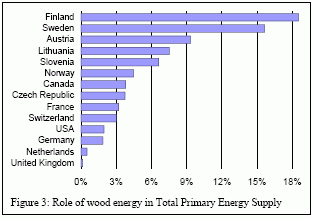Joint Wood Energy Enquiry
The UNECE/FAO Timber Section in cooperation with the International Energy Agency (IEA) decided in June 2006 to develop and launch a "Joint Wood Energy Enquiry". As of December 2006, 14 countries had replied to the enquiry and provided valuable information on wood energy in their country.
Together with its partners, the Timber Section used the detailed information to draft a report on wood energy which is being circulated for correction and comments among interested experts and national correspondents.
The aim of the Joint Wood Energy Questionnaire is to provide policy makers with more precise information on the national/regional level on:
- Roundwood equivalent used for energy production
- Sources for wood energy production (direct/indirect/post consumer)
- Wood energy's share of national/regional energy/bioenergy production.
- Consumers of wood energy
Results of the Joint Wood Energy Enquiry
First results were presented at the 2nd meeting of the Task group in Brussels in December 2006. The draft report was presented to the 29th Joint FAO/UNECE Working Party on Forest Economics and Statistics in March 2007.
The Joint Wood Energy Enquiry (JWEE) was carried out jointly by four international organizations (UNECE, FAO, IEA and EU) with the objective to respond to the following questions:
- How much wood is used for energy at present?
- from what sources?
- for what purposes?
- How important is wood energy for the national energy supply?
The data, from 12 European and two northern American countries, allow these first conclusions:
 Harvested wood volumes, in particular wood for energy generation, seem to be significantly higher
than reported by official international statistics. Wood used for energy generation is sometimes not
captured by official trade and consumption statistics (e.g. informal wood market for private
households/missing trade classification for wood pellets).
Harvested wood volumes, in particular wood for energy generation, seem to be significantly higher
than reported by official international statistics. Wood used for energy generation is sometimes not
captured by official trade and consumption statistics (e.g. informal wood market for private
households/missing trade classification for wood pellets).
Most of the wood used for energy arises during the processing, or after the use, of forest products such as sawnwood, panels and paper. Wood energy supplied directly from the forest is smaller but plays an important role, especially in the European countries. However it is safe to assume that in most advanced countries there is limited scope to increase the energy use of co-products (residues) from the forest products industry. There are also clear technical limits on the use of recovered wood, although it is not yet clear how much this sector could expand.
 Significant expansion of wood energy supply to meet ambitious biomass energy targets may therefore
be focused on direct energy. This could take the form either of mobilizing a greater share of the
existing resources and/or extending the forest area (for instance for energy plantations). The speed of
growth will depend on economic circumstances and policy choices, notably about land use priorities.
Significant expansion of wood energy supply to meet ambitious biomass energy targets may therefore
be focused on direct energy. This could take the form either of mobilizing a greater share of the
existing resources and/or extending the forest area (for instance for energy plantations). The speed of
growth will depend on economic circumstances and policy choices, notably about land use priorities.
The information of the enquiry complements studies on potential wood volumes for energy use. We hope that the data collected, if of sufficient quality, will be a baseline for future data collection. Concerned sectors (e.g. pellets producing industries, recycling and waste management etc.) and specialists are the most welcome to join the cooperative effort to improve data.
Downloads >>
Joint Wood Energy Enquiry - draft results and conclusions - March 2007[![]() 2.0 mb]
2.0 mb]
>>
Joint Wood Energy Enquiry replies [![]() 1.0 mb]
1.0 mb]
>> Presentation
on IEA/UNECE/FAO Joint wood energy enquiry at the COST E-31 (recovered wood) meeting, Lisbon
Nov 2006 [![]() 1.5 mb]
1.5 mb]
>> Joint
Wood Energy Enquiry 2006 [![]() 0.3 mb]
0.3 mb]
>> Introduction and Definition
to the Wood Energy Enquiry [![]() ]
]

 back to top
back to top